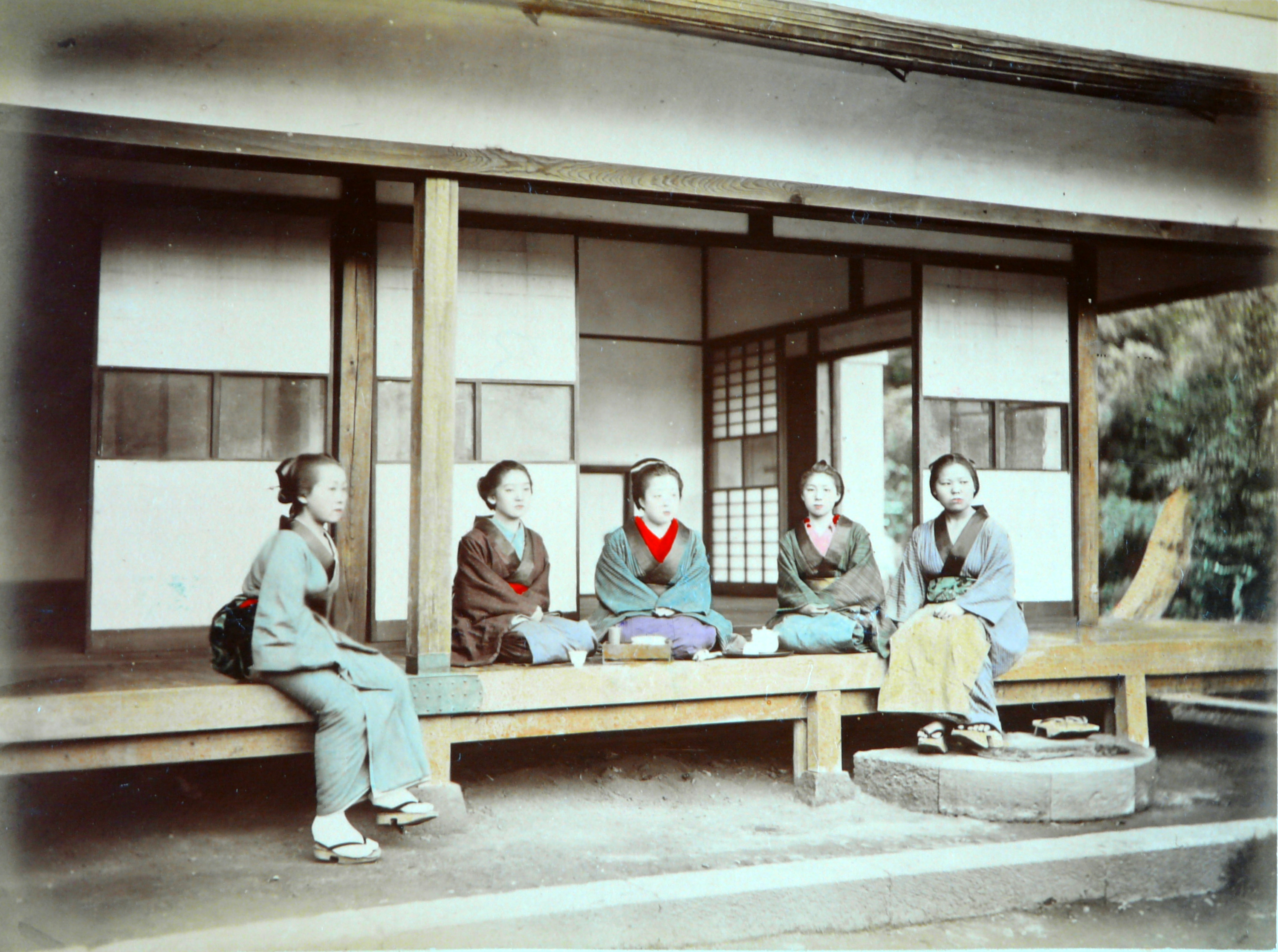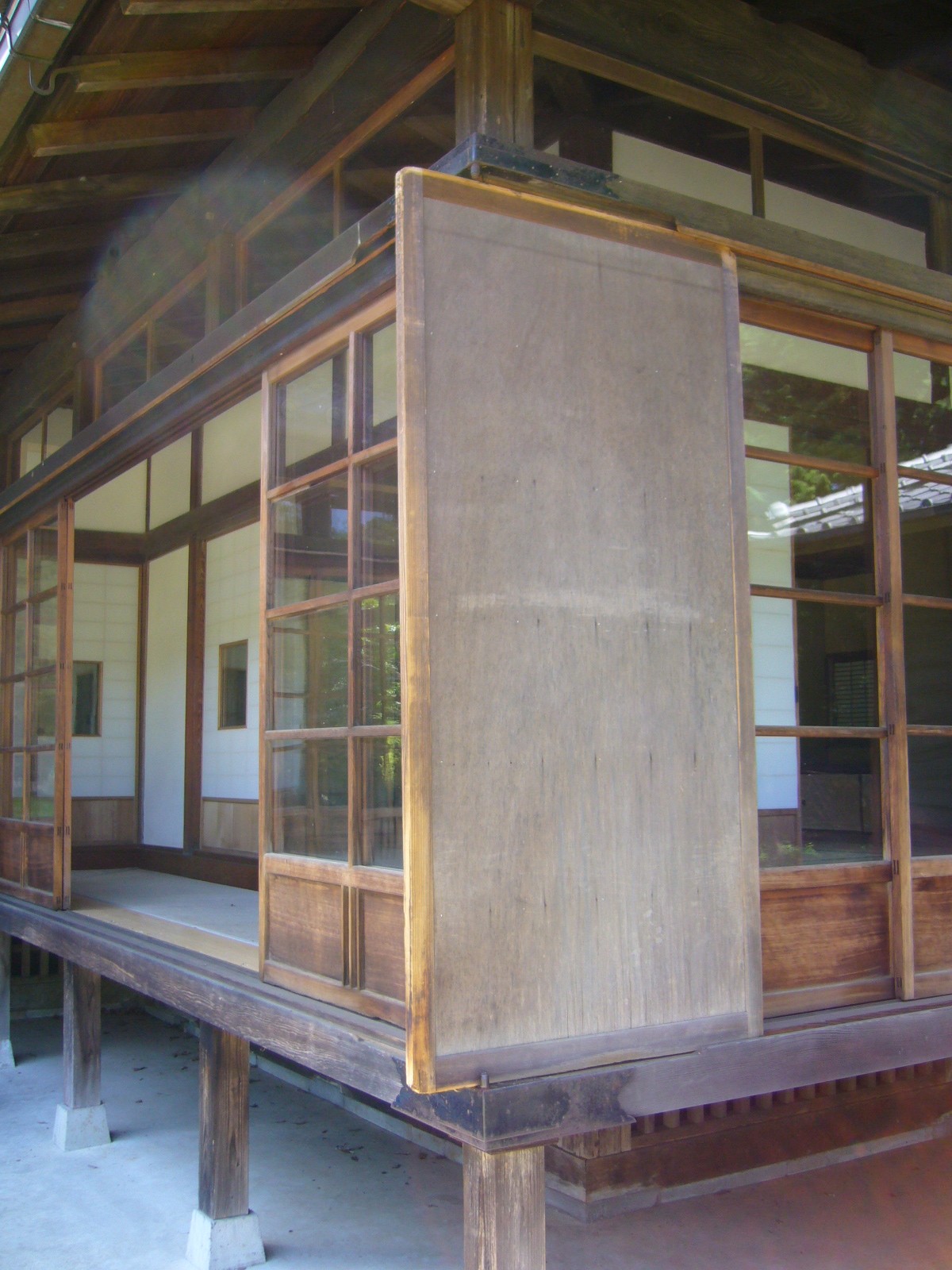Engawa on:
[Wikipedia]
[Google]
[Amazon]

 An or is an edging strip of non-
An or is an edging strip of non-
 means an edge; a side. The terms and were historically used interchangeably, but now generally refers to the
means an edge; a side. The terms and were historically used interchangeably, but now generally refers to the
File:Yakushi-do - Gokokuji - Bunkyo, Tokyo, Japan - DSC07838.JPG, , an which continues all around the building
File:風土記の丘の古い家、縁側 - panoramio.jpg, showing traditional mitered corner treatment. in foreground.
File:Ishibe shukubanosato13s3200.jpg, . The gravel path may well double as a collector drain.
File:Raigoin (Higashiyama-ku, Kyoto)0751.JPG, Fast-draining in lower right corner, near a tap
File:Geppa-ro.jpg, in the Geppa-rō rustic tea pavilion, overlooking the water at
File:Moya_hisashi.svg, and . The may itself be an in small buildings, or it may be a second layer of tatami-floored rooms, with a hard-floored en running outside it.
Genji emaki TAKEKAWA Large.jpg, alt=A courtyard with on the left and rear sides, a low sitting-height rail on the left side only, and (bamboo roller blinds) flush to the right side; in the court, a single pink-flowering tree, looking onto a courtyard, illustration
吉田家住宅 中庭.jpg, alt=A garden courtyard with an about above the pale gravel, feature stones, a rain chain, and a planting of bamboo, ferns, grasses, and a creeping plant with small round leaves., Low running around a courtyard, 2012
File:Japanese House - Engawa.jpg, After rain; the eaves have kept the mostly dry, and the has kept the foundations of the house quite dry.
File:Expo 2005 of Satsuki and Mei’s House 15.jpg, Cushions on an protected by sliding glass doors. Note , stone step.
File:Jonge vrouw met lantaarn-Rijksmuseum RP-P-1956-612.jpeg, An is part of the house, and shoes are therefore not worn on it.
File:Erinji garden and Corridors.JPG, An overlooking Erin-ji Gardens.
File:Bewonderen van bloemstukken-Rijksmuseum RP-P-1961-30.jpeg, An can open the house to the surrounding landscape.
File:SHUNSHO-3-women.jpg, Socializing on an .
File:Young Men Sitting on Porch by Adolf de Meyer 1900-1910.jpg, Socializing on an .
File:Three children drawing, (on panels), Japan, 1909 LCCN2001705661.tif, Children playing on an ; they are drawing on the

tatami
A is a type of mat used as a flooring material in traditional Japanese-style rooms. Tatamis are made in standard sizes, twice as long as wide, about 0.9 m by 1.8 m depending on the region. In martial arts, tatami are the floor used for traini ...
-matted flooring in Japanese architecture
has been typified by wooden structures, elevated slightly off the ground, with tiled or thatched roofs. Sliding doors (''fusuma'') and other traditional partitions were used in place of walls, allowing the internal configuration of a space to ...
, usually wood or bamboo. The may run around the rooms, on the outside of the building, in which case they resemble a porch
A porch (from Old French ''porche'', from Latin ''porticus'' "colonnade", from ''porta'' "passage") is a room or gallery located in front of an entrance of a building. A porch is placed in front of the facade of a building it commands, and form ...
or sunroom
A sunroom, also frequently called a solarium (and sometimes a "Florida room", "garden conservatory", "garden room", " patio room", "sun parlor", "sun porch", "three season room" or "winter garden"), is a room that permits abundant daylight and ...
.
Usually, the is outside the translucent paper , but inside the storm shutters (when they are not packed away). However, some run outside the . that cannot be enclosed by , or sufficiently sheltered by eaves, must be finished to withstand the Japanese climate. Modern architecture often encloses an with sheet glass. An allows the building to remain open in the rain or sun, without getting too wet or hot, and allows flexible ventilation and sightlines.
The area under an is sloped away from the building, and often paved, to carry the water away. The area directly outside the paving is usually a collector drain that takes water still further away. The is thus a way to bridge the obstacles good drainage puts between the indoors and the outdoors.
Structure
The is supported on posts, identical to the other uprights of the house. A row of uprights runs long the inside of the , and the sliding screens run between these; a second row of uprights runs along the outside of the . The posts traditionally stand on half-buried stones, pounded into the earth with a specialized maul, and the wood posts shaped to fit the upper surface. More recent houses may use concrete footings. The floor may not be finished, or it may be polished or lacquered.Terminology
 means an edge; a side. The terms and were historically used interchangeably, but now generally refers to the
means an edge; a side. The terms and were historically used interchangeably, but now generally refers to the veranda
A veranda or verandah is a roofed, open-air gallery or porch, attached to the outside of a building. A veranda is often partly enclosed by a railing and frequently extends across the front and sides of the structure.
Although the form ''vera ...
directly outside the shutters. Types of include:
Positional terms
* , an inner , possibly enclosed * , an set one step below the floor (or ) inside it * , literally a "wet ", an protruding from under theeaves
The eaves are the edges of the roof which overhang the face of a wall and, normally, project beyond the side of a building. The eaves form an overhang to throw water clear of the walls and may be highly decorated as part of an architectural styl ...
and not protected by .
If there are fewer than three , an may be described by more than one of the positional terms.
Structural terms
* , a wrap-around , often a wrap-around veranda * , a with boards running across its width * , a with boards running along its length * , a veranda with a slatted floor for better drainage * , a bambooKatsura Imperial Villa
The , or Katsura Detached Palace, is an Imperial residence with associated gardens and outbuildings in the western suburbs of Kyoto, Japan. Located on the western bank of the Katsura River in Katsura, Nishikyō-ku, the Villa is 8km distant fro ...
(close-up
A close-up or closeup in filmmaking, television production, photography, still photography, and the comic strip medium is a type of shot (filmmaking), shot that tightly film frame, frames a person or object. Close-ups are one of the standard s ...
, drainage
Drainage is the natural or artificial removal of a surface's water and sub-surface water from an area with excess of water. The internal drainage of most agricultural soils is good enough to prevent severe waterlogging (anaerobic condition ...
)
File:Tabi miyage dai nishū, Ame no Kiyomizu-dera by Kawase Hasui.jpg, Broad at Kiyomizu-dera; the dry section may be seen to the right.
Relation to other house components
The core of a traditional Shinden-style building was the innermost room or (see diagram). This was surrounded by the , which was on the same level, and was usually inside the windows and storm shutters. The was often a ring of tatami-floored rooms, but could be an unmatted ; see also . In a large building, there could be further layers of tatami-floored rooms, courtyards, and further floorplan complications. In Shoin-style buildings, the positioning of the varied more, and the storm shutters slid rather than being hinged (usually horizontally). The modern Sukiya-style of building uses , storm shutters that not only slide but pack away in a cupboard called a by day; unlike the Shoin-style shutter, these generally run on the outside of the . The width of an varies with the building; is common, while large temples may have over of . The is supported on posts, identical to the other uprights of the house. The posts stand on half-buried stones or concrete footings.Cultural role
are often proportioned so that one can sit on the edge and observe the garden. They provide a space for playing children and casual visitors. An is part of the house, and shoes are therefore not worn on it. Guests' shoes are lined up pointing outwards. While declined with the Westernization of Japanese architecture, they are making a comeback in modern architecture.shōji
A is a door, window or room divider used in traditional Japanese architecture, consisting of translucent (or transparent) sheets on a lattice frame. Where light transmission is not needed, the similar but opaque ''fusuma'' is used (oshiire/ ...
. Note shoes on .
File:『雨過洗庭之図』-A Garden Refreshed by the Passing Rain (Ukasentei no zu) MET DP147704.jpg, Traditional in fancier buildings often have low railings, for leaning on while sitting on the . Westernization of clothing made sitting on the floor difficult; modern often have standing-height railings
File:Tashiro_Family's_Old_Residence_03.jpg, Left, an running between buildings, joining them.
File:Korshagenhus 2.jpg, Modern in Denmark
)
, song = ( en, "King Christian stood by the lofty mast")
, song_type = National and royal anthem
, image_map = EU-Denmark.svg
, map_caption =
, subdivision_type = Sovereign state
, subdivision_name = Kingdom of Denmark
, establish ...
.
See also
*Loggia
In architecture, a loggia ( , usually , ) is a covered exterior gallery or corridor, usually on an upper level, but sometimes on the ground level of a building. The outer wall is open to the elements, usually supported by a series of columns ...
* Bay window
A bay window is a window space projecting outward from the main walls of a building and forming a bay in a room.
Types
Bay window is a generic term for all protruding window constructions, regardless of whether they are curved or angular, or ...
* Oriel window
An oriel window is a form of bay window which protrudes from the main wall of a building but does not reach to the ground. Supported by corbels, brackets, or similar cantilevers, an oriel window is most commonly found projecting from an upper f ...
References
{{Japanese architectural elements Japanese architectural features Flood control